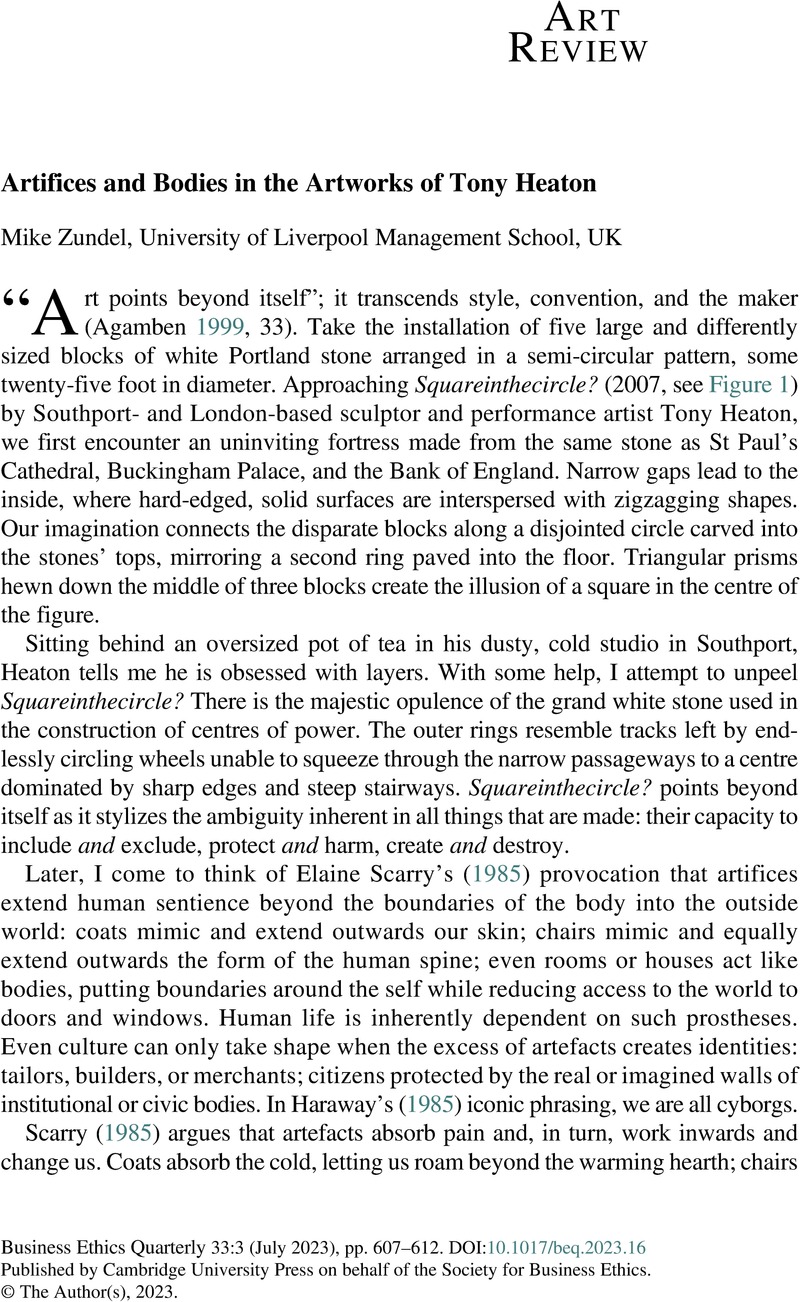No CrossRef data available.
Article contents
Artifices and Bodies in the Artworks of Tony Heaton
Review products
Artifices and Bodies in the Artworks of Tony Heaton
Published online by Cambridge University Press: 25 July 2023
Abstract
An abstract is not available for this content so a preview has been provided. Please use the Get access link above for information on how to access this content.

- Type
- Art Review
- Information
- Copyright
- © The Author(s), 2023. Published by Cambridge University Press on behalf of the Society for Business Ethics
References
REFERENCES
Agamben, Giorgio. 1999. The Man without Content. Translated by Albert, Georgia. Stanford, CA: Stanford University Press.CrossRefGoogle Scholar
Anders, Günther. 2016. “On Promethean Shame.” In Prometheanism: Technology, Digital Culture and Human Obsolescence, edited by Müller, Christopher John, 29–96. London: Rowman and Littlefield.Google Scholar
Bateson, Gregory. 1972. Steps to an Ecology of Mind: Collected Essays in Anthropology, Psychiatry, Evolution, and Epistemology. Northvale, NJ: Jason Aronson.Google Scholar
Brown, Steven D. 2016. “Violence and Creation: The Recovery of the Body in the Work of Elaine Scarry.” Subjectivity 9 (4): 439–58.CrossRefGoogle Scholar
Ghoshal, Sumantra. 2005. “Bad Management Theories Are Destroying Good Practices.” Academy of Management Learning and Education 4 (1): 75–91.CrossRefGoogle Scholar
Guffey, Elizabeth. 2020. “The Ideologies of Designing for Disability.” In Making Disability Modern: Design Histories, edited by Guffey, Elisabeth and Williamson, Bess, 101–13. London: Bloomsbury Visual Arts.CrossRefGoogle Scholar
Haraway, Donna. 1985. “Manifesto for Cyborgs: Science, Technology, and Socialist Feminism in the 1980s.” Socialist Review 80: 65–108.Google Scholar
Luhmann, Niklas. 2000. Art as a Social System. Translated by Knodt, Eva M. Stanford, CA: Stanford University Press.CrossRefGoogle Scholar
Monge, Rosemarie, and Hsieh, Nien-hê. 2020. “Recovering the Logic of Double Effect for Business: Intentions, Proportionality, and Impermissible Harms.” Business Ethics Quarterly 30 (3): 361–87.CrossRefGoogle Scholar
Pless, Nicola M., Maak, Thomas, and Harris, Howard. 2017. “Art, Ethics and the Promotion of Human Dignity.” Journal of Business Ethics 144: 223–32.CrossRefGoogle Scholar
Scarry, Elaine. 1985. The Body in Pain: The Making and Unmaking of the World. Oxford: Oxford University Press.Google Scholar
Siebers, Tobin. 2008. Disability Theory. Ann Arbor: University of Michigan Press.CrossRefGoogle Scholar
Williams, Jannine, and Mavin, Sharon. 2012. “Disability as Constructed Difference: A Literature Review and Research Agenda for Management and Organization Studies.” International Journal of Management Reviews 14 (2): 159–79.CrossRefGoogle Scholar


